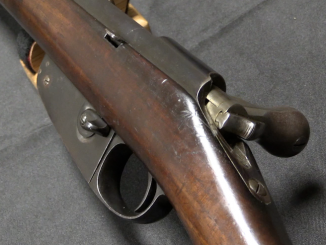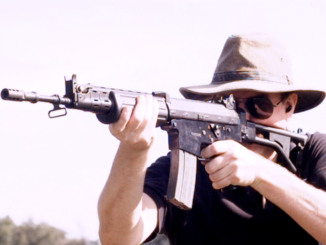After World War Two, FN put the BAR back into production. This was initially the FN-D version with a quick-change barrel, but with NATO’s adoption of the 7.62mm cartridge, there was a demand for the BAR in that chambering. The Belgian Army adopted this new round, and plenty of other nations did as well. This prompted FN to release a new version of the FN-D for it, designated the FN-DA1.
In addition to the new chambering, the DA1 also had these three changes:
– Larger bipod feet and a wider bipod stance
– A rear aperture sight instead of an open notch
– A more protected barrel release latch
The FN-DA1 would remain in production until 1967, when it was finally discontinued.




Ian I think the links to videos is broken
no he is being passive aggressive and doing that trying to force us to use utreon. i will stop watching ALL TOGETHER before i use utreon ever again.
Thanks for the explainer…my question is: who is expecting to get anything more significant from the video than the picture plus the text Ian posted? I just read that, looked at the picture and said “yup, next”
Reading about a semi auto/automatic looking at a photograph doesn’t cut it…
I was talking about live fire at the range
No he is not “passive-aggressive”. YouTube has been mucking around with its software again and has broken something. Other websites have also been affected by this and videos embedded there are broken, too.
I’m not sure if those BAR models also were exported to other South American nations. The Browning BAR reached to the Chilean Army in early 1960s decade and was in service until the late 1980s, so I don’t know if was in service in their original chambering (.30-06) or in 7.62 NATO (newly produced then or modifying original receivers rechambered for such caliber).
At least with the link to Themtube, it’s a lot easier to open it in invidious, and deny themtube the ability to track and profile who watches what.
Would love a comparative between this and the L4A4. I don’t think Britain made their gun as available on the world market, did they?
AFAIK the L4A4 were converted from existing British .303 Brens so a British Army only gun. Good idea to compare Stevo. The removable barrel on the BAR helps even things up a bit but I would have thought the top mag with would be better for sustained fire – good access for the no2 to change mags
That’s the critical difference between an Automatic Rifle, which nearly every BAR variant actually is, and an actual Light Machine Gun: The LMG can be served effectively by a crew. Automatic Rifle? Generally cannot, other than having them serve as ammo bearers.
TBH, I don’t think the BREN is in the same class as any of the BARs; it’s got the capacity for a tripod-mounting, top-fed magazines that can be accessed by the loader, and a slew of other minor features that enable actual MG use in a handy portable package. The BAR, for all of its virtues? It does not, so it isn’t in the same use-category at all.
For the last few days I haven’t been able to view the video’s on your web. I have to open them on Patrion. Did something change?
CHANGE: The video link is no longer “clickable”, but just plain text in the first line.
REMEDIAL ACTION:
Cut and paste the “youtu.be/….” text into the address field of your browser. Preferably in a new window. Hitting enter will take you directly to youtube and play the video.
At least this works for me (Firefox browser).
If you are using Firefox you might also highlight (select) not-a-link click right button of mouse and open in new tab.
Yeah, same here, except i watch on my phone with Safari.
For the last couple of days I haven’t been able to post because the FF browser claims there is a “security issue”.
cheers
eon
Thanks for the reply. Keep up the great work.
Browning and his successors knew what they were doing. I can’t really say the same for whichever morons designed the M60.
It’s the difference between a single engineer who knows what he wants to do, and a committee who are under orders to create something to a specification laid down by superiors who ultimately want an “in house” design they can take the credit for.
You have to remember that at the time JMB designed the BAR, nobody actually had a very clear idea of (1) what a “light automatic weapon” was, (2) how it should work, or even (3) what it would be used for, or how.
In some ways, this was an advantage for him, because like the old saying goes, “in the country of the blind, the one-eyed man is king”. He knew that he wanted to create a rifle capable of either semi- or full-automatic fire capable of being used by a single soldier as opposed to a machine gun team. the idea was to keep it on single-shot until a target worth a burst presented itself, then switch to full-auto and hit it with burst fire. In short bursts of no more than four or five rounds, for which a 20-round box magazine was enough, not to mention not encumbering the soldier with a bulkier and heavier feed system such as a belt or drum.
This is the definition of a machine rifle. A machine rifle and a light machine gun are not the same thing, nor are they generally used the same way. Browning understood this; to judge by the various iterations of his original design since his passing, I’m not sure anybody else ever did.
Other weapons like the Hotchkiss Portative (Benét-Mercié M1909 in U.S. service) came close to what Browning conceived. Some like the Chauchat might have succeeded if not for a fundamentally impractical design. Browning was the one who “got it right”.
As for the M60, it was intended as an American “answer” to the MG34 and MG42. The problem was that it was composed of design features copied from other designs by people who (1) were working to a specification that boiled down to “you will do it this way, and you will make it work” and (2) they thus added features to the design without necessarily understanding why they were on the other designs or what they were actually supposed to do. The feed cover assembly being just one example.
Some features indicated an astoundingly near-total ignorance of the way such a weapon was used in service. The bipod attached to the quick-change barrel and the lack of sight adjustment on said barrel(s) being an example of a point in which there was no understanding (exactly zero) of how such a gun was operated. A look at MG34, MG42, or any ZB26 “clone”, such as the Bren, would have told them that (1) you attach the bipod and/or tripod mounts to the gun body, not the barrel, and (2) the front sight is what must be adjustable for zeroing each barrel to the gun. The rear sight is mainly for changing settings for range.
The rest of the M60’s faults are the result of adopting production methods intended to keep cost and weight down without allowing for the IRWSH (In Real World S#!t Happens) factor. Things like not correctly staking pins, not allowing for things to be safety-wired against vibration (News flash; a machine gun vibrates when firing), and just making things too lightweight or of the wrong materials (plastic-covered cast-metal pistol grip….) all indicate that nobody in the project understood what the end-users’ actual needs were or would be.
In all seriousness, if the Ordnance Department wasn’t obsessed with their determination that everything had to be “theirs and theirs alone”, and had just held an actual competition to determine a “best choice” design, the “M60” would more likely have looked and worked much more like the SiG MG 710. Or to put it another way, the Mauser MG45 in 7.62 x 51mm.
If you think this is a new problem, think again. And while you’re at it, look up the history of the Ordnance Department going back to before the American Civil War.
cheers
eon
“(…)This is the definition of a machine rifle.(…)”
Now I am profoundly confused. If I understand http://www.historyofwar.org/articles/weapons_browning_automatic_rifle.html correctly enough “is machine rifle” pertains only to prototypes of Browning design used during Congress Heights demonstration, whilst production weapons belong to “automatic rifle”. Does “is automatic rifle” grant “is machine rifle”?
Most “automatic rifles” are properly “semi-automatic rifles”, the same way most “automatic pistols” are more correctly “semi-automatic pistols”. I.e., they are not designed for full-auto fire and most have no such provision.
The term “self-loading” rifle/pistol is probably more correct for both.
The term “machine rifle” was originally coined to distinguish between “self-loading” rifles that were not intended for full-automatic fire, and more heavily-built weapons intended for both semi- and full-automatic fire.
A machine gun (light, heavy, or whatever) is a fully-automatic weapon intended to be fired primarily on full-automatic; in fact it may have no provision for single-shot fire at all. It will generally have provisions for cooling the barrel, such as quick-change barrel, water cooling, or even multiple barrels (Gatling Gun type) that a “machine rifle” does not have, to ensure a high sustained automatic fire rate without damage to the weapon.
If you have a machine rifle that fires pistol ammunition, you have a submachine gun. If it fires an intermediate cartridge, you have an “assault rifle”. Anyone who thinks these are always lighter than a “normal” rifle has never dealt with a Model 1921 or 1928 Thompson with a full 50- or 100-round drum magazine onboard. (I have.)
Probably the nearest thing to a true “machine rifle” firing an intermediate cartridge would be the old Russian RPK. The Ultimax 100 came close, but it had no provision for single-shot and did have an interchangeable barrel, so it was more of a true “light machine gun”.
As with most things to do with ordnance, the definitions are often confusing.
cheers
eon
The language is inconsistent and confusing as hell–Which reflects the state of thought about the time all this was coming into existence. Automatic rifles were artifacts of the era when everything was manually-operated and magazine-fed; the idea of the automatic rifle or machine rifle was to supplement those weapons with something that was faster-firing, meaning it was necessarily more complex and expensive… Since they couldn’t afford to give everyone something that fed automatically, the supplemental idea worked.
The idea lives on in the Marine M27. I don’t know how viable it is, but the Marines think it’s a great idea, and if they can make it work, good on them. Me? I prefer a belt-fed in this role, something I can tear cover apart with, and which is good for stopping vehicles if need be.
The Marines have had a bit of a problem, for years–They seem to be wedded to this idea that the individual weapon is the ultimate fighting tool. Go back and take a look at what happened to the Marine Barracks in Beirut, and then look at what happened to those poor bastards in Ramadi. Both times, brave Marines were on entry control points armed with rifles. To stop trucks. In Beirut, rumor has it that ROE meant they weren’t even locked and loaded. Ramadi, those poor brave bastards were sitting there with just their individual weapons, staring down a truck bomb.
Marine leadership is kinda like the SEALS: Slow learners. Circa 1983, my Vietnam-era veteran leadership put a 90mm recoilless rifle at each ECP, and laid things out such that if someone tried running the ECP with a truck, they were getting stopped. Period. 90mm HEAT rounds fired lengthwise through a truck bomb pretty much put an end to that whole “vehicular movement” thing, emphatically. We also had slit trenches for the guys manning the ECP to drop into, in case things went way, way south. I remember wondering why the hell nobody else did that stuff in other units, and I was really shocked to observe that the Marines in Beirut weren’t taking such seemingly elementary precautions. Apparently, they didn’t learn much from that experience, and were still doing much the same thing in Ramadi and elsewhere in Iraq. Most Army bases over there had a tank or a Bradley backing up the gates, with the idea that the main guns would be the final line of protection.
To my jaundiced eye, the M27 is more of the same; a “rifleman’s rifle”, adopted in lieu of really effective weapons with a purblind mentality that the individual weapon and its operator can do everything. I personally disagree; horses for courses, and if some idiot tells me I need to stop a fscking dump truck loaded with high explosives with a rifle, he’s going to get a bit of a shock when I show up with a Carl Gustav or some other such weapon. Failing that, everyone coming into my ECP is going to be driving over a cratering charge whose firing mechanism is back up where the overwatch guys can detonate that bastard as needed. Riflemen need not apply, for anything other than verifying ID. So far as I’m concerned, the individual weapon is an accessory item only.
Eloquent and accurate summation. I need add nothing. The MAG-58 is a weapon designed by a singular series of geniuses, exquisitely adapted to the job. The M-60 is an abortion designed by a committee of uninterested halfwits who had no real idea what the hell a GPMG should be able to do, or how one was used.
The sighting system alone tells the tale. Swappable barrels, but the sights are zeroed on the rear sight, such that every barrel swap requires a re-zeroing with a rear sight that’s far from easily adjusted? Bastards didn’t even bother to give us a way to set the rear sight up such that you could easily go from one barrel to another; you had this little bitty screw on the elevation leaf that you’d have to fussily loosen, move the leaf, then tighten it. Imagine trying to do that in the middle of a damn firefight, willya…? Which is why most M-60 gunners didn’t even bother with the sights an awful lot of the time, with the attendant effects on delivery of accurate fire.
The M-60 is a testament to why you don’t treat weapons design like you’re building random widgets. Nobody involved with the M-60 seemed to have understood how machineguns in that class are actually used, in combat–And, it shows in nearly every feature of the gun.
I don’t think that very fair Chern. My grandfather was a raging alcoholic at the time he designed the M60, and things weren’t going well at his lawnmower repair shop. I think he did rather well for a man who consumed two bottles of old spice before breakfast.
“(…)raging alcoholic(…)”
But doesn’t that naturally trigger comparison with https://fi.wikipedia.org/wiki/Aimo_Lahti (which supposedly did have allowance from Mannerheim as long as he did his job)?
The FN-D was made in two different receiver lengths – one that is longer for 30-06, and a slightly shorter version for all other calibers. The additional length is necessary for the 30-06 magazines, which are about 1/8” longer than the 8mm magazines.
The 30-06 receiver cannot use the 308 lower and FAL magazines. FAL magazines will not seat unless you create some kind of spacer to support the front of the magazine and make up for the additional 1/8” in the magazine well. The 8mm FN-D can use the 308 lower and FAL magazines without any issues.
Re the use of FAL magazines in the FND-A1 – my recollection of my SLR (FAL) back in the day was that the magazine was inserted by first engaging the front of the magazine (which had a protrusion) into the magazine well and then rocking it back so that the catch then engaged. Ian’s demonstration showed the magazine on the gun being simply pushed into the well. So FAL magazines could not be used for this gun, no?
I honestly can’t tell if that’s a metric FAL magazine, or not. The inch-pattern ones have much more prominent front lugs, brazed-on ones. The metric jobs have a mere punched-out lip-like affair. Ian does not show that part of the magazine sufficiently well to really make out whether it’s a metric FAL body vice an actual metric FAL magazine. I think it could be just a FAL body that didn’t get the front lip on it, but… Can’t really tell. It certainly doesn’t insert like a FAL, rocking in from front to back.